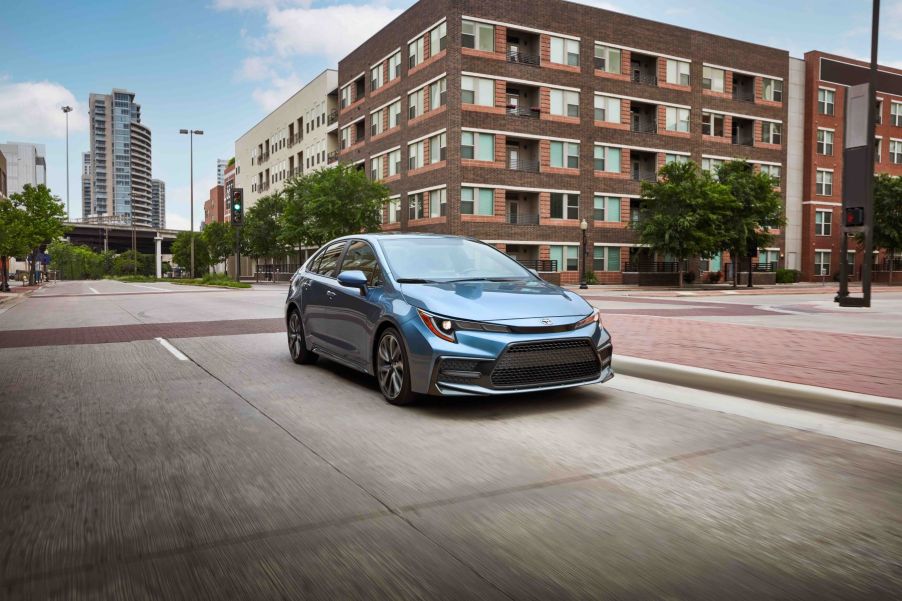
The 3 Safest Small Cars Under $25,000 Earned the Top Safety Pick+ Title From the IIHS
In a market where SUVs remain king, it would be understandable if smaller sedans fell by the wayside. However, the reality couldn’t be further from the truth, especially with car safety standards. Small cars are exposed to new and improved crash safety tests that ensure they can stand up to their larger competitors. Moreover, safety features once seen in premium picks have found their way to base models.
Not just any small car is safe, though. All must wade through the rigorous testing the government and non-profit organizations provide to determine which are trustworthy. Luckily, even those under $25,000 have what it takes to be designated a Top Safety Pick+.
What is a Top Safety Pick+?
The Insurance Institute for Highway Safety (IIHS) tests new vehicles to prove their crash safety credentials. The IIHS exists separately from the U.S. government’s National Highway and Transportation Safety Administration and its five-star safety assessment.
Car Connection explains that earning a Top Safety Pick+ designation requires vehicles to be awarded “Good” marks on six tests. They are as follows:
1. Overlap front testing that replicates a head-on collision between two vehicles traveling just below 40 mph.
2. Driver-side front overlap assessment that simulates a collision with a stationary object at 40 mph.
3. Passenger-side overlap testing that analyzes the same 40 mph collision with a stationary object.
4. A roof strength test assesses rollover safety.
5. Measurements of head restraints and front seat safety integrity.
6. A recently-revised side impact test that replicates the collision caused by an SUV.
2022 Honda Civic
Redesigned for the 2022 model year, Honda’s dependable small sedan received top marks in every IIHS safety category. The only less-than-stellar parameter was in the passenger-side front overlap test’s lower leg and foot region. Regardless of trim level, each Honda Civic comes standard with the Honda Sensing safety system.
Honda’s safety suite includes Adaptive Cruise Control (ACC), Lane Keeping Assist (LKA), Road Departure Mitigation, and Traffic Sign Recognition (TSR). The base LX and Sport trim levels also come fitted with a multi-angle rearview camera. The pricier EX-L adds the Blind Spot Information (BSI) system, and the top-of-the-line Sport Touring features BSI with cross-traffic monitoring. While the prime spec Civic starts a hair over $30,000, the base starts at $23,550.
2022 Toyota Corolla

The Toyota Corolla is no longer a vehicle that blends into the crowd. Although its aggressive looks make it stand out in the competition, it’s also become even safer to own. There isn’t much to judge safety-wise, as the Corolla was given top ratings in all six IIHS categories. However, it was lackluster in headlight crash avoidance. The XLE and XSE trim levels quell concerns with Toyota’s Advanced Lighting Package, which helps night visibility with curve-adapting headlights.
Standard on all 11 Corolla trim levels is Toyota Safety Sense 3.0. The system includes Dynamic Radar Cruise Control, Lane Departure Alert with Steering Assist, Pre-Collision System with Pedestrian Detection, Proactive Driving Assist, and Road Sign Assist. Optional on the $22,645 base LX is also Blind Spot Monitor (BSM) with Rear Cross-Traffic Alert (RCTA). Although the base model packs a fierce safety suite, pricier models include additional cameras and parking sensors.
2022 Mazda3
While the IIHS wasn’t too happy that not all Mazda3 trim levels have curve-adapting headlights, it was near-perfect in everything else. The manufacturer has also worked out reliability concerns three years after its complete redesign. Nevertheless, the sedan or hatchback version is one of the safest picks on sale today.
The Mazda is also abundantly equipped with safety features across the range. Standard features are ACC with Stop & Go, Driver Attention Alert, LKA, and Smart Brake Support. Only mid-range models like the Select get BSM with RCTA as standard. Additionally, only the Premium and 2.5 Turbo Premium Plus trims get TSR. Yet, the base 2.0 trim level has enough to make shoppers happy with a price tag of just over $21,000.
What is the safest small car to drive?
Realistically, any of the above cars will give drivers peace of mind on the road. The base model versions have standard safety features seen only in luxury business-class sedans a decade ago. However, there must be a winner.
Honda’s Civic features a safety suite similar to the rest, but the slight IIHS inadequacy knocks it out of the running. The Mazda3 and Toyota Corolla are matched in crash safety tests and standard crash mitigation features. They both fall short in curve-adapting headlights, which are options on higher-priced trim levels.
With adaptive headlights, the Toyota Corolla XLE with the Preferred Package is the lowest price that offers them at $24,825. The same feature on the Mazda3 is fitted to the Premium trim level, starting at over $26,000, Autotrader reports. Therefore, when it comes down to the best bang for your buck, the Toyota Corolla is here to please.


